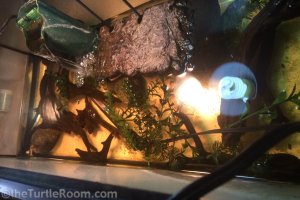Joe shares his husbandry and habitat design used for hatchling and juvenile Clemmys guttata (Spotted Turtles).
When I first started to care for hatchling North American Spotted Turtles I pictured it to be a daunting task, but that was far from the truth. I was stuck on the idea of how to create a proper enclosure while providing adequate filtration due to the Spotted Turtle’s poor ability to swim, when compared to most aquatic species. I soon realized that I was over thinking the care, and keeping things simple was the best method.
 Hatchling Clemmys guttata require extremely shallow water, as they do not have webbed feet for expert swimming. After my Spotted Turtles hatch, and after the yolk is absorbed, I place them into a small tupperware enclosure with 1-1.5″ of water. This depth still is too deep with out any assistance, so it is necessary to have plenty of floating plants and/or drift wood available for their use. These plants, real and fake, and drift wood allow the small turtles to be able to climb to the water’s surface to rest and breathe. Along with the plants and driftwood, the Spotted Turtles are given access to a dry basking spot with temperatures around 90 F as well as UV lighting. I tend to find that they are shy for the first year and rarely utilize the basking space, but it should still be provided. I also find that even hatchling Spotted Turtles do very well with water temperatures of 70-75°F. I keep a low-wattage water heater available in case the water drops below those temps, but temperatures of 70-75°F are fairly easy to maintain even without the water heater, especially if the room is kept between 70-75°F.
Hatchling Clemmys guttata require extremely shallow water, as they do not have webbed feet for expert swimming. After my Spotted Turtles hatch, and after the yolk is absorbed, I place them into a small tupperware enclosure with 1-1.5″ of water. This depth still is too deep with out any assistance, so it is necessary to have plenty of floating plants and/or drift wood available for their use. These plants, real and fake, and drift wood allow the small turtles to be able to climb to the water’s surface to rest and breathe. Along with the plants and driftwood, the Spotted Turtles are given access to a dry basking spot with temperatures around 90 F as well as UV lighting. I tend to find that they are shy for the first year and rarely utilize the basking space, but it should still be provided. I also find that even hatchling Spotted Turtles do very well with water temperatures of 70-75°F. I keep a low-wattage water heater available in case the water drops below those temps, but temperatures of 70-75°F are fairly easy to maintain even without the water heater, especially if the room is kept between 70-75°F.
Up to this point, keeping hatchling Spotted Turtles is rather simple. The primary issue to tackle is the choice of whether to replace the water regularly or to filter it. The shallow water depth can prove challenging to filter in order to maintain a clean enclosure. I start out replacing the water weekly. I also feed the hatchlings in a separate container outside of the enclosure to limit the amount of waste in the primary habitat. Once I can raise the water high enough for a small, submersible filter, I combine both methods of keeping water clean.  The small, submersible filters only do so much, so I also change out the water in the enclosure every 2-3 weeks. I also continue to feed in a separate container outside of the enclosure to limit the amount of waste in the primary habitat. I find that water quality is extremely important with Clemmys guttata in all stages of life. They tend to be susceptible to fungal issues, and I have had my fair share of them. In all of my Spotted Turtle enclosures I keep the water salted with aquarium salt. Generally, I follow the directions on the container for adding salt into freshwater enclosures. On top of the salt, I keep the water slightly acidic with the addition of tannin-leaching drift wood or leaves. Keep in mind that these should cleaned well before use to prevent the introduction of foreign lifeforms.
The small, submersible filters only do so much, so I also change out the water in the enclosure every 2-3 weeks. I also continue to feed in a separate container outside of the enclosure to limit the amount of waste in the primary habitat. I find that water quality is extremely important with Clemmys guttata in all stages of life. They tend to be susceptible to fungal issues, and I have had my fair share of them. In all of my Spotted Turtle enclosures I keep the water salted with aquarium salt. Generally, I follow the directions on the container for adding salt into freshwater enclosures. On top of the salt, I keep the water slightly acidic with the addition of tannin-leaching drift wood or leaves. Keep in mind that these should cleaned well before use to prevent the introduction of foreign lifeforms.
While I know the idea of keeping a shallow water species, like Spotted Turtles, properly can be a challenge, once you choose to keep your approach simple and do a little more work with maintaining water quality, they become much easier. Spotted Turtles are a beautiful species to work with and you shouldn’t let your concerns scare you away!


